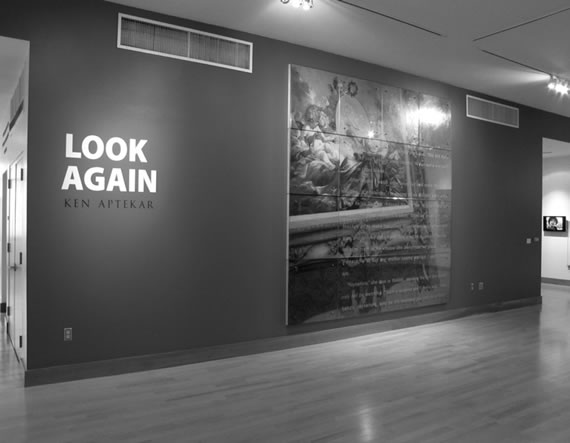His works are familiar.
In fact, they look just like the paintings of Raphael, Monet, and Rembrandt. But Ken Aptekar’s Look Again exhibit in the Beard & Weil Galleries in Watson Fine Arts is more than a collection of imitations. It is a combination of contemporary thoughts, comments, and stories, weaving together to create a different way of viewing art.

Aptekar paints with oil on wood, but then makes the painting “pop” – literally. On sandblasted glass, he writes stories, phrases, and words, and then bolts the glass over the painting, creating a 3D effect. Exhibit viewers said that his works were “sophisticated installations.”
Sometimes, the words are funny. In a recreation of Chasse au loup by Jean-Baptiste Oudry, orange and red wolves snarl and attack the words “A Reason to Wake Up Each Morning.” Conveniently, those words are the title of the artwork.
In other cases, the words are personal. Aptekar interviewed various people in galleries to understand their reactions to old artworks. Over Saying Grace and Young Man with Violin by Chardin, Aptekar wrote what French woman Arlette L’Hopitault saw in these paintings: “the sweet harmony of family.” He continued to describe her reaction, which morphed into a life story about her tough childhood and disappointing adulthood. Here Aptekar combines a physical portrait of Chardin’s works with an emotional portrait of Arlette L’Hopitault, allowing for multiple interpretations of the artwork. The painting is called The Story of Arlette L’Hopitault.
Aptekar himself is “tall and friendly,” stated Rose Liu ’13 who works at the Watson Gallery. “He’s not the stereotype of an artist – he’s not crazy. He has European roots and influences and he is very socialized.”
Aptekar’s one self-portrait is not visual, but textual. On When Someone Asks Me What I Do, he paints a clear canvas frame and writes, “When someone asks me what I do, I say I’m an artist who ‘uses’ paintings. I paint an image from the history of art and bolt glass with words over it. The text is one piece of a puzzle; the painting between the lines is a clue.”
However, he makes it clear that there is no answer to the mystery to which he alludes. In an interview by The Jewish Museum New York, he says, “There is no formula… The hope is that these paintings that I make will allow contemporary viewers to think about the paintings of the past in relationship to their own lives.”
Aptekar is not only a painter, however. In the middle of the gallery is a room that screens Aptekar’s film, Three Acts, which chronicles his make-up transformation into Louis XV and Madame de Pompadour. In this video, one senses his character; nonchalant, humorous, and fascinating, he stares idly, pines for music (“I’m a Survivor” then roars through the speakers), and eats random sweets throughout the video, which fades from his headshot to images of Versailles.
Aptekar’s paintings probe questions of materiality, identity, reality, masculinity and spectatorship. The exhibit displays in the Beard & Weil Galleries in Watson Fine Arts until April 14.
